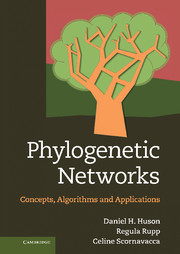Book contents
- Frontmatter
- Contents
- Preface
- Part I Introduction
- Part II Theory
- Part III Algorithms and applications
- 7 Phylogenetic networks from splits
- 8 Phylogenetic networks from clusters
- 9 Phylogenetic networks from sequences
- 10 Phylogenetic networks from distances
- 11 Phylogenetic networks from trees
- 12 Phylogenetic networks from triples or quartets
- 13 Drawing phylogenetic networks
- 14 Software
- Glossary
- References
- Index
11 - Phylogenetic networks from trees
from Part III - Algorithms and applications
Published online by Cambridge University Press: 05 August 2011
- Frontmatter
- Contents
- Preface
- Part I Introduction
- Part II Theory
- Part III Algorithms and applications
- 7 Phylogenetic networks from splits
- 8 Phylogenetic networks from clusters
- 9 Phylogenetic networks from sequences
- 10 Phylogenetic networks from distances
- 11 Phylogenetic networks from trees
- 12 Phylogenetic networks from triples or quartets
- 13 Drawing phylogenetic networks
- 14 Software
- Glossary
- References
- Index
Summary
In this chapter, we look at a number of methods that take as input one or more phylogenetic trees and compute as output a phylogenetic network. We first discuss methods for computing consensus trees and consensus split networks from unrooted phylogenetic trees, and then briefly touch on doing the same for rooted phylogenetic trees. We then present an algorithm for computing a minimum hybridization network for two trees. The two last topics in this section both address the issue of gene duplications. First we discuss how to compute a phylogenetic network for a given multi-labeled phylogenetic tree. Then we discuss an approach used for computing an optimal duplication-loss-transfer scenario that reconciles a gene tree with a species tree.
Consensus split networks
Assume that we are given a collection T = (T1, …, Tk) of unrooted phylogenetic trees on X. They might be different phylogenetic trees inferred for different genes, a collection of trees obtained for a single gene using a number of different tree inference methods or a list of trees produced via bootstrapping or a sampling approach, for example.
Such a collection of unrooted phylogenetic trees T is often represented by a single consensus tree, as discussed in Section 3.17. Recall that two standard approaches to computing a consensus tree both start by determining the splits associated with each tree in T, and then either consider the set Sstrict(T) of all splits that occur in every tree, or consider the set Smajority(T) of all splits that occur in more than half of the trees.
- Type
- Chapter
- Information
- Phylogenetic NetworksConcepts, Algorithms and Applications, pp. 265 - 299Publisher: Cambridge University PressPrint publication year: 2010



